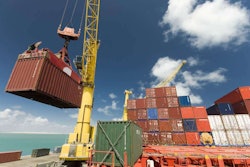 The Port of Los Angeles faced a major cargo backlog earlier this year following months of tense negotiations between port workers and port management companies.
The Port of Los Angeles faced a major cargo backlog earlier this year following months of tense negotiations between port workers and port management companies.U.S. retail ports are experiencing an upswing in import volume while West Coast dockworkers diminish a freight backlog and ratify a new labor agreement.
Last week, morning commuters encountered longer than usual truck lines on the New Jersey Turnpike Extension. Construction on the Bayonne Bridge may be partly to blame, but state officials indicated the problem stems from truckers waiting to get in the Global Marine Terminal at Bayonne/Jersey City.
On April 10, the Port Authority of New York and New Jersey asked for a delay in truck dispatches because of very heavy truck volume in the terminal’s vicinity.
Trucks have been arriving increasingly earlier before the gates open, it reported. “The result is that traffic is blocked on all access roads to the facility including Route 440 and the NJ Turnpike extension well before the gates open,” the authority stated.
The National Retail Federation said it expects this month an 8 percent hike in import cargo at the nation’s major retail container ports, compared to April 2014.
On the West Coast, 78 percent of International Longshore and Warehouse Union delegates approved April 3 a five-year contract plan with the Pacific Maritime Association.
The union will mail the proposed agreement to members before a secret ballot membership ratification vote, followed by final tally May 22.
The West Coast cargo backlog accumulated between last fall and Feb. 20, when the Pacific Maritime Association and the ILWU reached tentative agreement, said Jonathan Gold, a NRF vice president.
“Progress is being made but there’s still a lot of cargo waiting to be loaded onto trucks and trains and moved across the country even after it’s unloaded from the ships,” Gold said. “The situation is getting better but we’re still far from normal.”
February container volume was down nearly 4 percent from February 2014. But March traffic is estimated to have grown 3.5 percent from a year before, while 5.6 percent hike is forecast for April and May over the previous time last year, the NRF stated.
Nine ships awaited anchor at Southern California ports April 9, down from a high of 32 vessels Feb. 18. The Port of Oakland reported that the vessel backlog that began in January had “disappeared” by April 2, with no ships awaiting berth in the San Francisco Bay.
Federal Maritime Commissioner Michael Khouri wants fresh information on the steps the four major alliances of vessel operators are taking to reduce congestion in U.S. ports. On March 17, Khouri asked the agency to make the request after the FMC received private reports and read media accounts that the alliances’ operations may contribute to the problems at ports.













